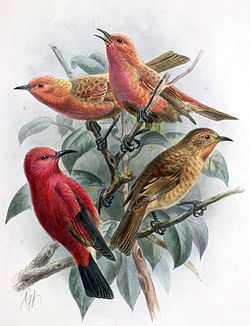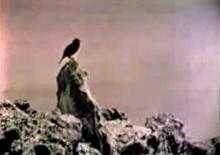Laysan Honeycreeper
| Laysan ʻApapane | |
|---|---|
 | |
| Painting by John Gerrard Keulemans. A male adult, B Female adult, C Juvenile, D ʻApapane | |
| Conservation status | |
| Scientific classification | |
| Kingdom: | Animalia |
| Phylum: | Chordata |
| Class: | Aves |
| Order: | Passeriformes |
| Suborder: | Passeri |
| Parvorder: | Passerida |
| Family: | Fringillidae |
| Subfamily: | Carduelinae |
| Tribe: | Drepanidini |
| Genus: | Himatione |
| Species: | H. sanguinea |
| Subspecies: | H. s. freethi |
| Trinomial name | |
| Himatione sanguinea freethi (Rothschild, 1892) | |
| Synonyms | |
|
Himatione freethi | |
The Laysan Honeycreeper or Laysan ʻApapane (Himatione sanguinea freethi) was a subspecies of the ʻApapane endemic to the island of Laysan in the Northwestern Hawaiian Islands. Based on cranial osteology, it may have represented a distinct species.[1]
Description


An adult male Laysan Honeycreeper had vermilion upperparts, an ashy-brown lower abdomen and underwing-coverts, and brownish-white undertail-coverts. Adult females similar to male, but with paler red feathers. After molting, feathers were brighter and faded with sunlight exposure.[1]
Diet
Laysan Honeycreeper fed on nectar from the native flowers on the island, especially maiapilo (Capparis sandwichiana). When populations of that species declined, it was forced to feed on nectar from ʻākulikuli (Sesuvium portulacastrum) and ʻihi (Portulaca lutea). It was observed visiting koali ʻawa (Ipomoea indica), pōhuehue (I. pes-caprae brasiliensis), and nohu (Tribulus cistoides), and would also feed on caterpillars and moths. Unlike the nominate subspecies, the Laysan Honeycreeper foraged on the ground.[1]
Breeding
Laysan Honeycreeper primarily nested in the center of tall grass bunches, but sometimes built nests in dense ʻāheahea (Chenopodium sandwichensis) shrubs. Nests were made of rootlets interwoven with grass blades. The Laysan ʻApapane had a clutch size of four to five eggs.[1]
Extinction
Domestic rabbits were introduced to the island in the late 19th century, and quickly consumed nearly all vegetation on the island, including nectar sources for the Laysan Honeycreeper. The bird was filmed in 1923 during the Tanager Expedition. Shortly after, Laysan was battered by a strong storm, and later attempts at finding any remaining Laysan ʻApapane failed.[2] Other birds also inhabited the island, including the Laysan Millerbird, the Laysan Rail, the Laysan Duck, and the Laysan Finch. Of these, only the finch and the duck remain extant.
References
- ↑ 1.0 1.1 1.2 1.3 Fancy, Steven G; C. John Ralph (1997). "ʻApapane" (PDF). In A. Poole; F. Gill. Birds of North America 296. Academy of Natural Sciences.
- ↑ "1923 USS Tanager Expedition". Video. Northwestern Hawaiian Islands Mult-Agency Education Project. Retrieved 2009-03-16.
